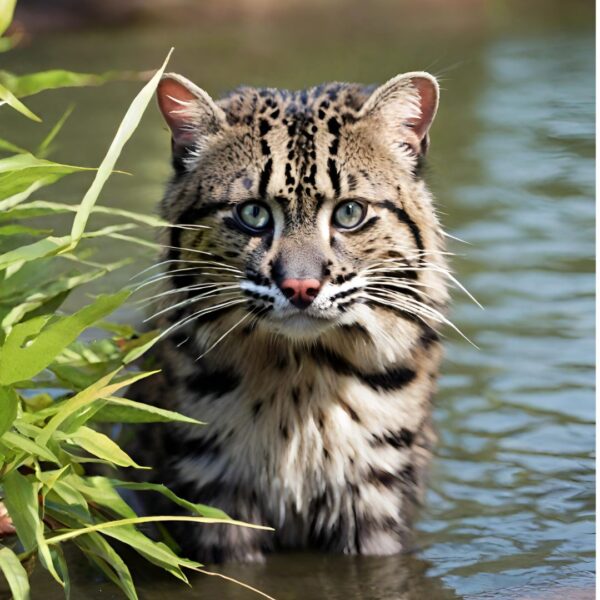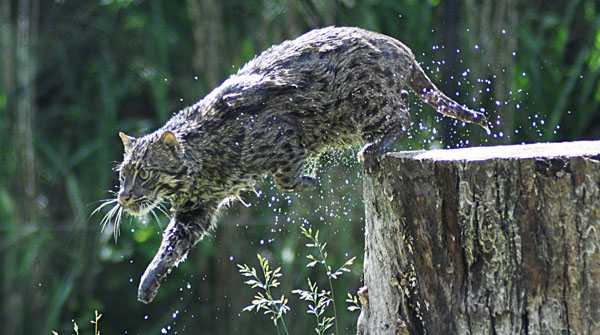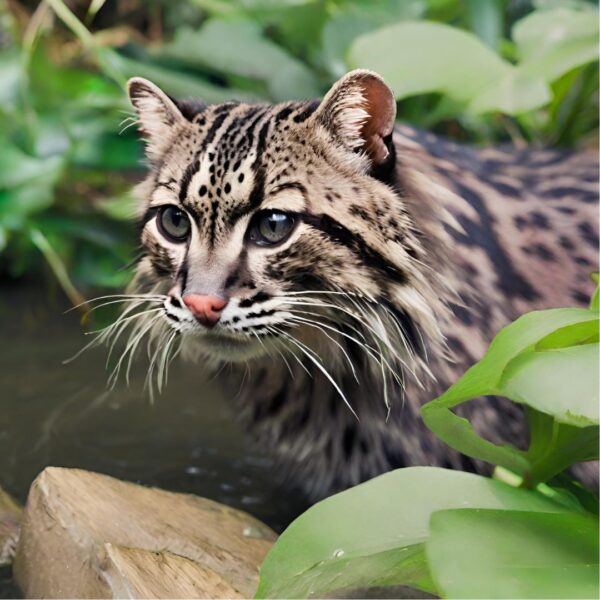
Do Wild Cats Eat Fish: Diet of Cats in the Wild
Wild cats are known for their hunting prowess and ability to take down prey much larger than themselves. However, the question of whether wild cats eat fish remains a topic of debate among researchers and wildlife enthusiasts alike. While some species of wild cats are known to consume fish, others rarely if ever include fish in their diet.
The dietary habits of wild cats vary widely depending on the species, their geographic location, and the availability of prey in their habitat. Some wild cats, such as the fishing cat, are known for their affinity for fish and are adapted to hunting in aquatic environments. Other species, such as the African lion, primarily hunt large mammals such as antelope and wildebeest.
The role of fish in wild cat diets is influenced by a variety of factors, including the availability of prey, the season, and the habitat in which the cat lives. Anatomical and physiological adaptations, as well as environmental influences, also play a role in determining what wild cats eat. Understanding the dietary habits of wild cats is important for conservation efforts and for ensuring the health and nutrition of these predators.
Key Takeaways
- Wild cats have varying dietary habits, with some species consuming fish and others not.
- The role of fish in wild cat diets is influenced by factors such as prey availability, season, and habitat.
- Anatomical and physiological adaptations, as well as environmental influences, play a role in determining what wild cats eat.
Wild Cats Dietary Habits
Carnivorous Nature and Nutrient Requirements
Wild cats are obligate carnivores, meaning they require a diet that consists primarily of meat to meet their nutritional needs. Their digestive system is adapted to digest and absorb nutrients from animal protein, fat, and amino acids. They have a higher requirement for protein than most other mammals due to their high metabolic rate and lean body mass.
In addition to protein, wild cats require specific nutrients such as taurine, vitamins, and minerals to maintain their health. Taurine is an essential amino acid that is found only in animal tissue and is crucial for the proper functioning of the heart, eyes, and immune system. Vitamins and minerals are also important for various physiological processes, including bone growth, blood clotting, and energy metabolism.
Prey Spectrum of Wild Cats
Wild cats have a diverse prey spectrum that varies depending on their habitat, prey availability, and hunting skills. They primarily hunt small mammals, birds, and rodents, but they may also prey on insects, reptiles, and fish. Larger wild cats such as lions and tigers may also hunt larger mammals such as deer and antelope.
Fish is not a common prey item for most wild cats, but some species such as the fishing cat (Prionailurus viverrinus) and the leopard cat (Prionailurus bengalensis) are known to feed on fish. The diet of feral domestic cats and their hybrids in Hungary was found to consist primarily of small mammals, with fish occurring rarely in their diet. Another study found that fish contributed only 9% by weight to the diet of feral cats in Kinchega, Australia.
In conclusion, wild cats are obligate carnivores that require a diet consisting primarily of meat to meet their nutritional needs. They have a diverse prey spectrum that varies depending on their habitat and prey availability, but fish is not a common prey item for most wild cats.

Do Wild Cats Eat Fish? Role of Fish in Wild Cat Diets
Wild cats are known for their hunting skills and their ability to acquire nutrients from a variety of prey. In this section, we will explore the role of fish in the diets of wild cats.
Types of Fish Consumed by Wild Cats
If you are wondering if wild cats eat fishW, wild cats consume different types of fish depending on their habitat and availability.
Fishing cats, which are known for their affinity for water, primarily feed on fish. They are adept at catching fish and use their hunting skills to locate and catch their prey. In addition to fish prey consumed by fishing cats include waterfowl, frogs, snakes, snails, and crustaceans.
The flat-headed cat is an excellent swimmer and it specializes in hunting aquatic prey. Its diet consists mainly of frogs, crustaceans, and fish, which the cat catches using its partially webbed paws. It has also been observed to consume rats and other small mammals when available. The flat-headed cat’s hunting habits are specifically adapted to its habitat, which typically includes swamplands, marshes, and areas near rivers or streams.
Jaguars are opportunistic hunters and can prey upon almost anything they come across. Capybaras, deer, tortoises, iguanas, armadillos, fish, birds and monkeys are just some of the prey that jaguars eat.
Studies have shown that bobcats mostly eat rabbits and rodents (rodents such as cotton rats, mice and squirrels), but will also eat birds, deer and occasionally reptiles and amphibians. It’s unusual for bobcats to eat fish and fish would make up very small percentage of the diet. Bobcats are opportunistic hunters unlikely to actively search for fish. However, given the chance and opportunity, the wild cat will take it. One bobcat was caught dragging a small shark from the ocean!
Other species of wild cats, such as the African wildcat, also consume fish but to a lesser extent. They are known to consume fish such as tilapia and catfish, which are found in the water bodies of their habitat.
Hunting Techniques for Aquatic Prey
Wild cats use different hunting techniques to catch fish. Fishing cats, for example, are skilled at catching fish in shallow water. These clever cats will tap their paw on the water surface to mimic insects and wait. They use their sharp claws to scoop up fish from the water and their powerful jaws to hold onto their prey. They are also known to dive into the water to catch fish.
Other species of wild cats, such as the African wildcat, catch fish by stalking them along the banks of rivers or streams. They use their stealth and agility to approach their prey and then pounce on them.
Fish is small part of the diets of many species of wild cats. It provides them with essential nutrients such as omega-3 fatty acids, which are important for their overall health and well-being. Wild cats use their hunting skills to catch fish and have adapted to different hunting techniques depending on their habitat and the type of fish available.

Anatomical and Physiological Adaptations
Wild cats are known for their hunting skills, and their diet varies depending on their habitat and prey availability. These cats have anatomical and physiological adaptations that allow them to digest and absorb nutrients from fish.
Digestive System and Nutrient Absorption
The digestive system of wild cats that feed on fish is adapted to handle the unique challenges of a fish-based diet. For example, the European wild cat has shorter intestines than domestic cats, which allows for faster digestion of fish. Additionally, wild cats that feed on fish have a higher concentration of digestive enzymes that break down fish protein, making it easier to absorb nutrients.
Teeth and Claws for Predation
Wild cats that feed on fish also have adaptations in their teeth and claws that make them more efficient predators. For example, the fishing cat has sharp, curved teeth that allow it to catch and hold onto fish, while the European wild cat has strong, sharp claws that help it catch and hold onto prey.
Overall, wild cats have adapted to their environments and prey availability, and their anatomical and physiological adaptations allow them to thrive in their natural habitats.

Environmental Influences on Diet
Wild cats have adapted to a wide range of habitats and environmental conditions. As such, their diets can vary greatly depending on the season, prey availability, and habitat-specific factors.
Seasonal Variation in Prey Availability
In many habitats, seasonal changes can have a significant impact on the availability of prey species. For example, in temperate regions, many small mammals hibernate during the winter months, which can limit the prey options for wild cats. As a result, wild cats may shift their diet to include more birds, fish, and other prey that are available year-round.
In contrast, during the summer months, wild cats may have access to a wider variety of prey, including small mammals, birds, and insects. This increased prey availability may allow wild cats to consume a more balanced diet that meets their nutritional needs.
Habitat Specific Diets
Wild cats have adapted to a variety of habitats, including deserts, savannas, and forests. As such, their diets can vary depending on the specific habitat they inhabit.
For example, wild cats that live near water sources may have access to fish and other aquatic prey, which can make up a significant portion of their diet. In contrast, wild cats that live in desert habitats may rely more heavily on small mammals and reptiles for survival.
In addition to habitat-specific factors, wild cats may also have species-specific dietary preferences. For example, some wild cats may have a greater preference for certain types of prey, such as birds or rodents, which can influence their diet.
Overall, wild cats are adaptable and opportunistic predators that can survive on a wide range of prey species. Their diets are influenced by a variety of environmental factors, including season, habitat, and prey availability.
Health and Nutrition Concerns
Risks of a Fish-Based Diet
While it is true that many wild cats, such as fishing cats, consume fish as a part of their natural diet, a fish-based diet can pose several health risks to domestic cats. One of the primary concerns is the potential for mercury poisoning. Fish, particularly larger predatory fish, can contain high levels of mercury, which can accumulate in a cat’s body over time and lead to serious health issues.
Another concern is the risk of choking or intestinal blockage from fish bones. Even small bones can cause significant problems, including vomiting, diarrhea, and even death if the bone becomes lodged in the cat’s throat or intestines.
Nutritional Imbalances and Deficiencies
A fish-based diet can also lead to nutritional imbalances and deficiencies in cats. While fish is a good source of protein and essential fatty acids, it is not a complete source of nutrition for cats. Cats require a balanced diet that includes a variety of nutrients, including vitamins, minerals, and hydration.
Consuming too much fish can also lead to an imbalance of essential fatty acids in a cat’s diet. While fish is high in omega-3 fatty acids, it is low in omega-6 fatty acids, which are also essential for a cat’s health. This imbalance can lead to skin and coat problems, as well as other health issues.
In conclusion, while wild cats may consume fish as a part of their natural diet, domestic cats can face several health and nutrition concerns from a fish-based diet. Cat owners should ensure that their cats are receiving a balanced diet that includes a variety of nutrients to maintain their health and wellbeing.

do wild cats eat fish? Comparison with Domesticated Cats
Differences in Diet and Hunting Behavior
While both wild and domesticated cats are obligate carnivores, there are some differences in their natural diet and hunting behavior. Wild cats hunt for their food in the wild and have a more varied diet compared to domesticated cats. They hunt for small mammals, birds, reptiles, and even fish. Domesticated cats, on the other hand, rely on their owners to provide them with food and typically only eat meat-based commercial cat food.
The hunting skills of wild cats are also more developed compared to domesticated cats. Wild cats have to hunt for their food in the wild and have developed skills, such as stalking, pouncing, and killing their prey. Domesticated cats, on the other hand, may not have as much opportunity to develop these hunting skills as they are often fed by their owners.
Impact of Domestication on Nutritional Needs
Domestication has also had an impact on the nutritional needs of cats. Domesticated cats have been bred over generations to have a more docile temperament and be more suitable as pets. As a result, their nutritional needs have also changed. While both wild and domesticated cats require a high protein diet, domesticated cats have a more limited diet compared to wild cats.
Domesticated cats typically only eat meat-based commercial cat food, which may not provide all the nutrients they need. Wild cats, on the other hand, have a more varied diet and can obtain all the nutrients they need from their natural prey.
In conclusion, while both wild and domesticated cats are obligate carnivores, there are some differences in their natural diet and hunting behavior. Domestication has also had an impact on the nutritional needs of cats, with domesticated cats have a more limited diet compared to wild cats.

Do Wild Cats EAt Fish? Frequently Asked Questions
What types of prey do wild cats commonly consume?
Wild cats are known to consume a variety of prey, including small mammals such as rodents, rabbits, and hares, as well as birds, reptiles, and amphibians. Larger wild cats, such as lions and tigers, will also hunt larger prey such as antelopes, zebras, and buffalo.
How frequently do wild cats catch and eat fish?
While wild cats are not typically known for their ability to catch fish, there are some species that will consume fish if they are available. For example, fishing cats, which are found in Southeast Asia, are known for their ability to catch fish, and will frequently hunt in and around waterways. However, fish are not a staple in the diets of most wild cats.
Is it safe for cats to have fish as a staple in their diet?
While fish can be a healthy source of protein and omega-3 fatty acids for cats, it is important to ensure that they are not consuming fish exclusively. Fish can contain high levels of mercury and other toxins, which can be harmful to cats in large quantities. Additionally, fish that are not properly prepared can contain harmful bacteria or parasites.
Do wild cats show a preference for fish over other types of meat?
There is no evidence to suggest that wild cats have a preference for fish over other types of meat. While some species of wild cats, such as fishing cats, are known to consume fish, this is likely due to the fact that they are abundant in their natural habitats. In general, wild cats will consume whatever prey is available to them.
What are the reasons behind cats’ strong attraction to fish?
Cats are attracted to the smell and taste of fish, which can be attributed to their natural hunting instincts. Fish are a rich source of protein and omega-3 fatty acids, which are essential nutrients for cats. Additionally, the strong smell of fish can stimulate a cat’s appetite and make them more interested in their food.
How does the hunting behavior of domestic cats compare to wild cats regarding fish?
While domestic cats may occasionally catch and consume fish, their hunting behavior is generally less specialized than that of wild cats. Domestic cats are opportunistic hunters and will consume whatever prey is available to them, whether it be rodents, birds, or insects. However, some domestic cats may show a preference for fish-flavored cat food due to their natural attraction to the smell and taste of fish.